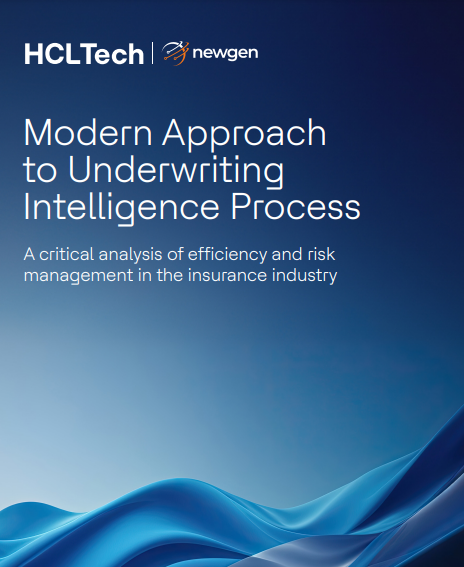Advancing Commercial Insurance from Hindsight to Foresight
Underwriting lies at the core of commercial insurance profitability. Every decision shapes risk exposure, portfolio health, and long-term business resilience. Yet underwriting systems and workflows have remained largely unchanged for years. Manual inputs, siloed data, and legacy processes make underwriters spend significant time on activities that do not drive strategic value. As commercial risks become more complex and market dynamics continue to change rapidly, insurers must evolve how underwriting decisions are made, monitored, and improved.
This whitepaper explores how commercial underwriting can transition from reactive analysis to proactive risk intelligence. With modern digital capabilities and collaboration between technology partners, insurers can simplify workflows, accelerate quote responses, and strengthen portfolio profitability.
The Urgency for Underwriting Transformation
Commercial insurance has entered a period where traditional methods struggle to keep pace with reality. Economic fluctuations, climate-driven events, supply challenges, and emerging coverage needs have made underwriting accuracy more critical than ever. At the same time, underwriters are burdened with administrative tasks that limit their focus on evaluating difficult cases and analyzing broader portfolio risks.
Operational challenges holding insurers back include:
- Manual data entry and fragmented data sources
- Disjointed workflows that slow decision cycles
- Limited visibility into risks, claims history, and coverage gaps
- Inconsistent risk appetite adherence across underwriters
- Difficulty tracking pricing guardrails and guidelines
- Delays that damage broker and customer trust
Outdated systems reduce responsiveness in competitive environments, causing missed opportunities and portfolio imbalances.
Why Modernizing Underwriting Is Complex?
Unlike standardized personal lines, commercial risks vary widely across industries, geographies, and business models. Determining accurate property values, managing risk engineering insights, and pricing for evolving threats requires deeper expertise and access to better data. Underwriting maturity depends on the ability to:
- Capture high quality risk submissions from brokers
- Analyze multiple risk factors quickly and consistently
- Apply granular rules with guardrails that adapt to market conditions
- Maintain transparency for every decision made
When systems cannot support these needs, decision confidence decreases and exposure increases.
The Foundation: Data That Works at the Speed of Risk
Data drives underwriting quality. However, insurers struggle with disconnected data environments where important information is stored in multiple systems or external tools. Without a unified view of submissions and contextual insights, underwriters spend considerable time gathering details instead of evaluating the risk.
A strong data foundation enables:
- Standardized and validated intake information
- Pre-filled details where possible to reduce rework
- Faster risk capture and allocation to expert teams
- Streamlined collaboration across underwriting, actuarial, and distribution
When data becomes more accessible and reliable, decision-making improves across the enterprise.
The Four Pillars of Underwriting Intelligence
This whitepaper highlights a strategic model where modern underwriting transformation is built across four key pillars.
1. Streamlined Intake
Risk submission quality determines downstream productivity. Improving intake ensures:
- Single source entry for all information
- Automation of classification and triage
- Real-time orchestration with existing underwriting systems
- Reduction in back-and-forth communication
Cleaner intake leads to faster assignment and more accurate evaluations.
2. Connected Insights
To avoid surprises, underwriters need complete visibility into:
- Loss history
- Exposure indicators
- Internal and third-party intelligence
- Risk scoring and appetite alignment
Better insight helps align pricing and terms with true exposure rather than assumptions.
3. Transparent Orchestration
Process governance improves when the right actions flow automatically to the right stakeholders. Workflow automation ensures:
- Faster time to quote
- Automated updates to internal and broker teams
- Improved operational control and oversight
- Better collaboration across working groups
Every stakeholder gains clarity without chasing status updates.
4. Intelligent Pricing
Pricing discipline is essential when volatility rises. Intelligent pricing systems support:
- Granular evaluation of risk criteria
- Consistency in how pricing factors are applied
- Scenario analysis to balance competitiveness and profitability
Pricing moves closer to science rather than intuition.
Reimagining the Underwriter Experience
Modern underwriting technology is designed to act as an assistant, not a replacement. It enables underwriters to focus their expertise where it matters. By reducing repetitive tasks and assembling information automatically, advanced systems remove operational noise and support better decision-making.
With a modern workbench, underwriters get:
- A simplified digital workspace
- Real-time risk context in one place
- Tools for faster evaluation and communication
- Higher productivity with reduced friction
This enhances both job satisfaction and underwriting value.
Scalable Evolution Rather Than Disruption
Transformation must be incremental to ensure business continuity. Insurers can adopt technology in phases:
- Digitize intake for immediate productivity gains
- Introduce workflow intelligence for faster throughput
- Expand data integrations for deeper insights
- Automate pricing guardrails and recommendations
- Scale success to more lines and markets
This approach balances innovation and stability.
Partnership for Stronger Outcomes
The whitepaper highlights the strategic partnership between HCLTech and Newgen to enhance underwriting operations. Together, the capabilities of intelligent automation, integrated workflows, and unified data access enable insurers to accelerate underwriting turnaround and improve consistency across decisions. Carriers benefit from faster implementation while leveraging existing technology investments.
The Future of Underwriting Begins Now
Commercial insurance requires underwriting practices that can adapt quickly, maintain discipline, and capitalize on market opportunities. Digital modernization creates the ability to act ahead of risk rather than after outcomes are visible. As automation improves the efficiency of day-to-day tasks, underwriters can devote more energy to evaluating high-value submissions and strengthening portfolio resilience.
Better tools lead to better underwriting. Better underwriting creates more sustainable growth.
Underwriting transformation is not a trend but a necessity. The carriers that invest today will achieve stronger differentiation, faster responsiveness, and more confident portfolio performance through intelligence-driven decisioning.

